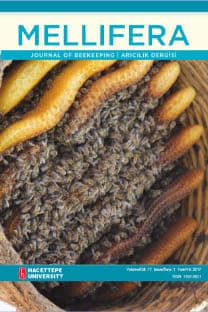Chemical Content and Bioactive Properties of Drone Larvae (Apilarnil)
Bu çalışmada, erkek arı larvasının (apilarnil) besin elementleri, aminoasit içeriği ve biyoaktif özellikleri belirlenmiştir. HPLC-UV ile yapılan analiz sonuçlarına göre apilarnil’de 16 amino asit belirlenmiştir. Esansiyel amino asitlerden yalnızca triptofan tespit edilememiştir. En yüksek amino asit miktarı 7198 mg/100g olan lizin amino asidi iken en düşük metionin amino asidi olup 500 mg/100g olarak belirlenmiştir. Elde edilen sonuçlara göre apilarnilin nem, kül, protein, karbonhidrat ve lipit içeriği sırasıyla 4.43, 4.07, 48.75, 21.62 ve 21.13 g/100 g dır. Apilarnilin biyoaktif özelliklerini belirlemede fenolik madde içeriği için Folin-Ciocalteu metodu, antioksidan aktivite için fosfomolibden metodu ve antiradikal aktivite için DPPH metodu kullanılmıştır. Apilarnilin toplam fenolik madde içeriği 834,05 (mg GAE/100 g) iken antioksidan aktivitesi 90,91 mg AAE/g bulunmuştur. Erkek arı larvasının (apilarnil) antiradikal aktivite inhibisyon düzeyi % 81.61 olarak tespit edilmiştir. Sonuç olarak, apilarnilin faydalı biyolojik aktivitesi antioksidan aktivitesinden kaynaklanıyor olabilir.
Keywords:
Apilarnil drone larvae,
___
- 1 YÜCEL, B; KÖSOĞLU, M (2015). Apiterapide apilarnil. Arı Ürünleri ve Sağlık. Sidaş Yayıncılık, İzmir. ISBN: 9786055267261 2 YÜCEL, B; AÇIKGÖZ, Z; BAYRAKTAR, H; SEREMET, Ç (2011). The effects of apilarnil (drone bee larvae) administration on growth performance and secondary sex characteristics of male broilers. J Anim Vet Adv, 10 (17): 2263-2266. 3 ALTAN, Ö; YÜCEL, B; AÇIKGÖZ, Z; SEREMET, C; KÖSOĞLU, M; TURGAN, N; ÖZGÖNÜL, AM (2013). Apilarnil reduces fear and advances sexual development in male broilers but has no effect on growth. Br Poult Sci, 54(3):355-361. 4 BOLATOVNA, KS; RUSTENOV A; ELEQALİEVA, N; OMİRZAK, T; AKHANOV, UK (2015). Improving reproductive qualities of pigs using the drone brood homogenate. Biol Med (Aligarh), 7 (2): BM-091-15. 5 SHOINBAYEVA, KB; OMIRZAK, T; BIGARA T; ABUBAKIROVA A, DAUYLBAY A (2017). Biologically active preparation and reproductive function of stud rams. Asian Journal of Pharmaceutics (AJP): Free full text articles from Asian J Pharm 11(03): 184-191. 6 VALER’EVNA ZE, IVANOVİCH BG, VİKTOROVİCH NA,GENNADEVİCH KO, MİKRTİCHİAN MG, VALERİEVNA ZJ, KUZMİNİCHNA KE. (2018) Hormonal Status and Productıve Qualıtıes of Young Pıgs at Inclusıon In a Dıet Feedıng Homogenate Drone Brood, Сельскохозяйственные науки (Agric Sci) 636: 612-636. 7 BALKANSKA, R; KARADJOVA, I; IGNATOVA, M (2014). Comparative analyses of chemical composition of royal jelly and drone brood. Bulg Chem Commun 46(2): 412-416. 8 BARNUTIU, LI; MARGHİTAŞ, LA; DEZMİREAN, D; BOBIŞ, O; MIHAı, C; PAVEL, C (2013). Physico-chemical composition of Apilarnil (Bee drone larvae). Seria Zootechnie, 59:199-202. 9 FINKE, MD (2005). Nutrient composition of bee brood and its potential as human food. Ecol Food Nutr, 44(4): 257-270. 10 GOINS, A; SCHNEIDER, SS (2013). Drone “quality” and caste interactions in the honey bee, Apis mellifera L. Insectes sociaux, 60(4): 453-461. 11 HRYNIEWICKA, M; KARPINSKA, A; KIJEWSKA, M; TURKOWICZ, MJ; KARPINSKA, J (2016). LC/MS/MS analysis of α‐tocopherol and coenzyme Q10 content in lyophilized royal jelly, beebread and drone homogenate. Journal of mass spectrometry, 51(11):1023-1029. 12 MATSUKA, M; WATABE, N; TAKEUCHI, K (1973). Analysİs of the food of larval drone honeybees. J Apic Res, 12(1): 3-7. 13 STAGACIU, S (1999). Apilarnil. Apitherapy course notes. P.520, Romania. 14 KOGALNİCEANU, S; LANCRAJAN, I; ARDELEAN, G (2010). Changes of the glucidic metabolism determined by the physical effort of the treatment with the Aslavital and Apilarnil. Arad Med J, 3:33-41. 15 SAWCZUK, R; KARPINSKA, J; MILLTYK, W (2019). What do we need to know about drone brood homogenate and what is known. J Ethnopharmacol 5(245): 111581. 16 CONSTANTIN, D. 1989. Rezultate obpinute in tratamentul cu apilarnil potent a tulburarilar de dinami camsexuale. Romanian Apicult, 10: 21. 17 ILIESIU NV (1980). Apilarnil. The 8th biologically active bee product. Apic Romania 12:4 18 AOAC Authors. Official methods of analysis nitrogen-free extract calculatiob: 100 minus (moisture+ ash+ protein+ fiber+fat)-item 93. Association of Analytical Communities, Gaithersburg, MD, 17 th edition, 2006, NFNAP: PROX. 19 JENSEN AB; EVANS, J; JONAS-LEVI A, BENJAMIN O; MARTINEZ I; DAHLE B; ROOS N; LECOCQ A; FOLEY K. (2019) Standard methods for Apis mellifera brood as human food, J Apic Res 58 (2):1-28, 20 HU, F; LI, Y (2001). Nutritive value and pharmacological actions of Italian worker bee larvae and pupae. In Proceedings of the 37th International Apicultural Congress, Apimondia, Durban. 21 MARGAOAN, R; MARGHITAS, LA; DEZMIREAN, DS; BOBIS, O; BONTA, V; CATANA, C; URCAN, A; MUREŞAN, CI; MARGIN, MG (2017). Comparative study on quality parameters of royal jelly, apilarnil and queen bee larvae triturate. Bulletin of University of Agricultural Sciences and Veterinary Medicine Cluj-Napoca. Anim Sci Biotechnol 74(1): 51-58. 22 LAZARYAN, DS (2002). Comparative amino acid analysis of bee brood. Pharm Chem J, 36(12): 680-682. 23 ÖZKÖK, D; SİLİCİ S (2017). Antioxidant activities of honeybee products and their mixtures. Food Sci Biotechnol 26(1): 201-206.
- ISSN: 1302-5821
- Başlangıç: 2001
- Yayıncı: Hacettepe Üniversitesi
Sayıdaki Diğer Makaleler
Bioactive Properties of Blossom and Honeydew Honeys
The Effects of Environmental Problems on Honey Bees in view of Sustainable Life
Effects of Royal Jelly Supplementation on Growth Plate Zones and Longitudinal Growth in Young Rats
Özgür PİRGON, Müge ATAR, Metin ÇİRİŞ, Murat SEVER
Assia HABBI-CHERIFI, Noureddine ADJLANE, Ferroudja MEDJDOUB-BENSAAD, Nizar HADDAD
Chemical Content and Bioactive Properties of Drone Larvae (Apilarnil)
Assia HABBI-CHERIFI, Noureddine ADJLANE, Ferroudja MEDJDOUB-BENSAAD, Nizar HADDAD
